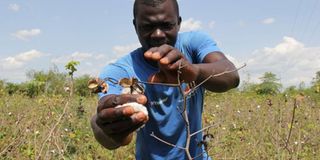Why revival of cotton industry in Nyanza may take longer

Steve Otieno, a cotton farmer in God Jope, Homa Bay County in this picture taken on June 29, 2020.
What you need to know:
- Farmers sell their cotton to cooperative societies, which in turn sell to ginners.
- Farmers say one with an acre can only make a Sh8,000 profit.
Fluctuating prices and ineffective management of cooperative societies are derailing the revival of the cotton industry in Siaya county.
Farmers in Rarieda are stuck with 8,000 tonnes of cotton after a bumper harvest two months ago.
Mr Willis Ochieng, one of the affected farmers, said some families began harvesting their cotton in late September but cannot sell it due to the low prices offered.
Mr Ochieng, who had an acre under cotton, said the price of a kilo has fallen from Sh52 to Sh48.
The Directorate of Fibre Crops, which is under the Agriculture Food Authority (AFA), convenes a stakeholders’ meeting to review prices every year. They price usually depends on trends in the global market.
The annual meeting is usually attended by farmers’ representatives, ginners, spinners and officials from the regulator.
Farmers say they feel shortchanged as they were not represented at this year’s forum. To produce a tonne of cotton, one uses at least Sh40 ,000.
Farmers sell their cotton to cooperative societies, which in turn sell to ginners. Farmers say one with an acre can only make a Sh8,000 profit.
Mr Zedekiah Adul Ajuang, who put three acres under cotton in the last season, said producing the crop is labour intensive.
He said the cotton variety farmers are being encouraged to grow takes nine months to mature and requires to be weeded five times.
“The returns are not worth the effort,” Mr Ajuang told the Nation on Tuesday.
He added that the black cotton soil in parts of Rarieda favours weeds.
Pests are also common, meaning the cotton has to be sprayed several times before it is ready for harvesting.
Mr Ajuang is the secretary of 4,000-member Uyuma Cotton Growers Cooperative Society, which was revived in 2013.
Members of the society planted a fast maturing and high yielding cotton variety.
“An acre of land can produce 1.5 tonnes of this variety. For the local variety, one can only get 600 kilos,” Mr Ajuang said.
The co-op society expects 8,000 tonnes of cotton this year. It bought 143 tonnes from farmers last year.
For the 30 years he has grown cotton, Mr Ajuang has encountered many challenges.
Once lucrative industry
He says lack of political goodwill and liberalising the market almost ground the once lucrative industry to a halt.
“The free market economy meant the government could not set or regulate prices. The cotton sub-sector almost collapsed since brokers took advantage of the situation to exploit farmers,” Mr Ajuang said.
The government then established the Fibre Crops Directorate under AFA.
The directorate was given the mandate to regulate the price of cotton, license ginners and ensure farmers are not exploited.
But the farmers’ woes are far from over. The BT cotton variety, which was introduced in Kenya and popularised by the Ministry of Agriculture, is not readily available.
The variety grown in Siaya county ends up being attacked by pests and diseases three months after being planted.
The once vibrant ginneries have all but collapsed.
The more than 7,000 members of Asembo and Uyoma cooperative societies in Rarieda sell their cotton in Salawa, Elgeyo Marakwet county.
Rarieda cooperative officer Mary Muyoyo said value addition would ensure farmers earn more from their cotton and other crops.
“This is possible when there is a ginnery. Farmers will earn from cotton lint, oil and cake which fetch better prices,” Ms Muyoyo said.
AFA senior technical officer Harrison Fundi said fluctuating cotton prices have been occasioned by low demand in the international market.
He added that the coronavirus pandemic has also contributed to the decline in demand.
“The annual stakeholders meeting decides the prices. The directorate then implements the resolution of the deliberation,” he said.
Mr Fundi advised farmers to bulk their cotton in order to negotiate for better prices.
“After the minimum price is set, the buying begins in October and ends in February. We don’t allow ginners to buy directly from farmers. They must also buy within the set standards like the use of digital weighing scales,” he said.





